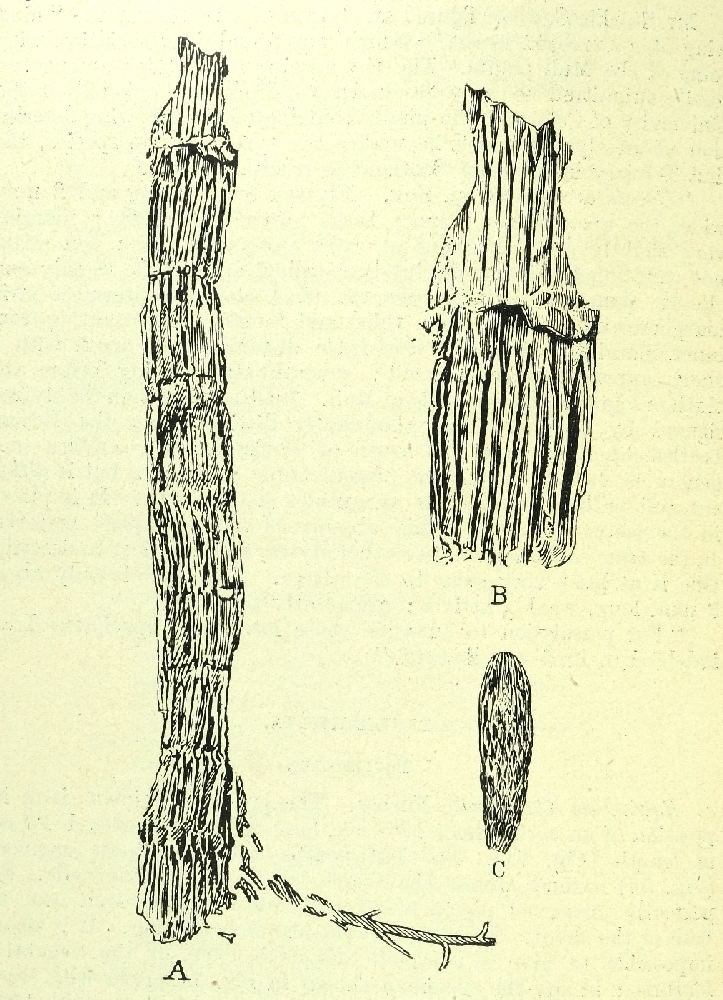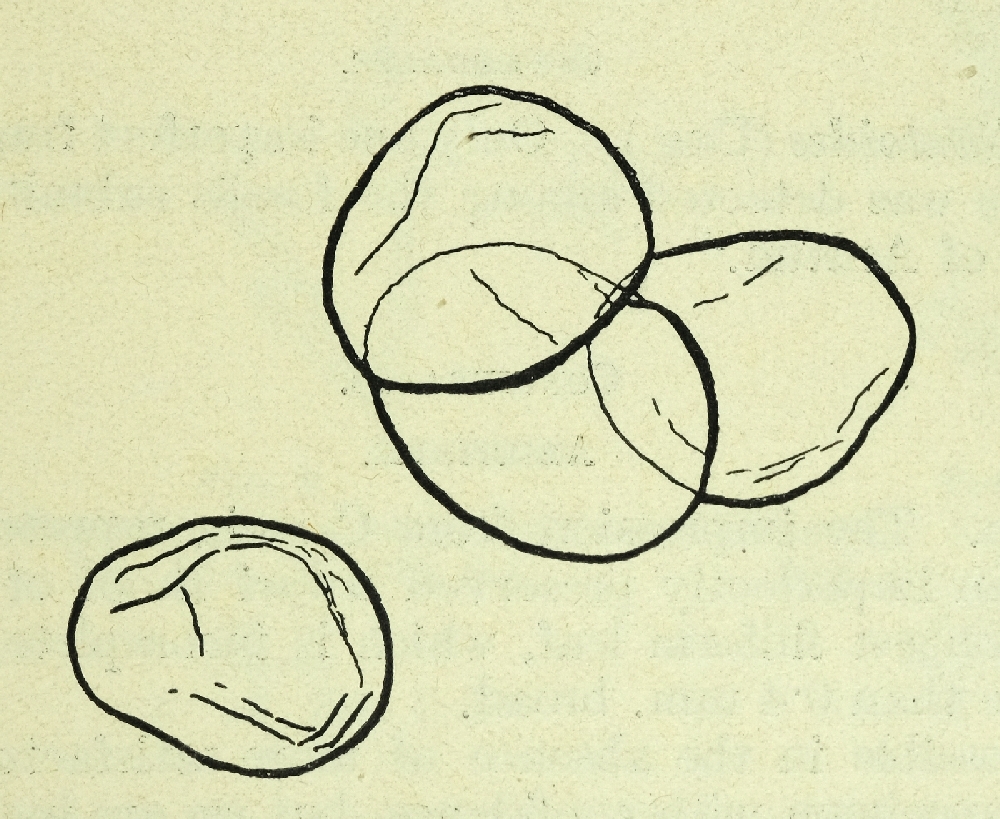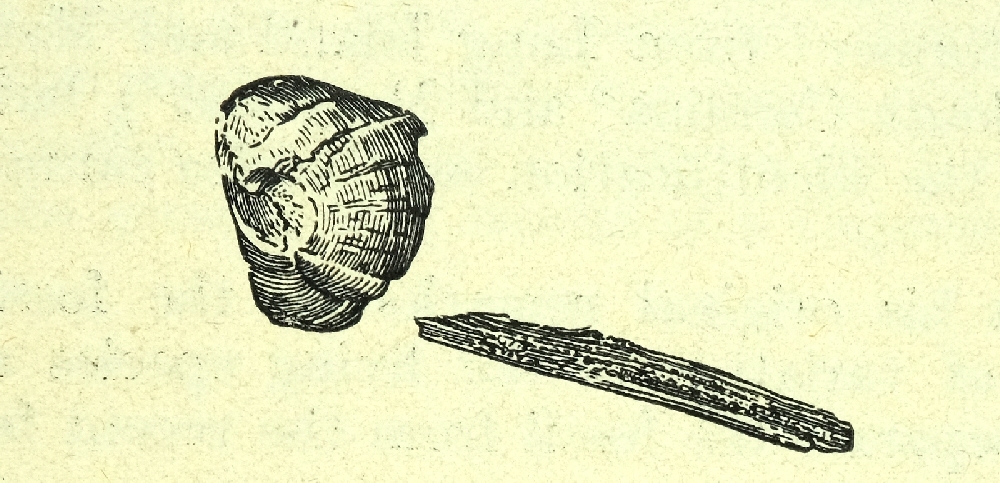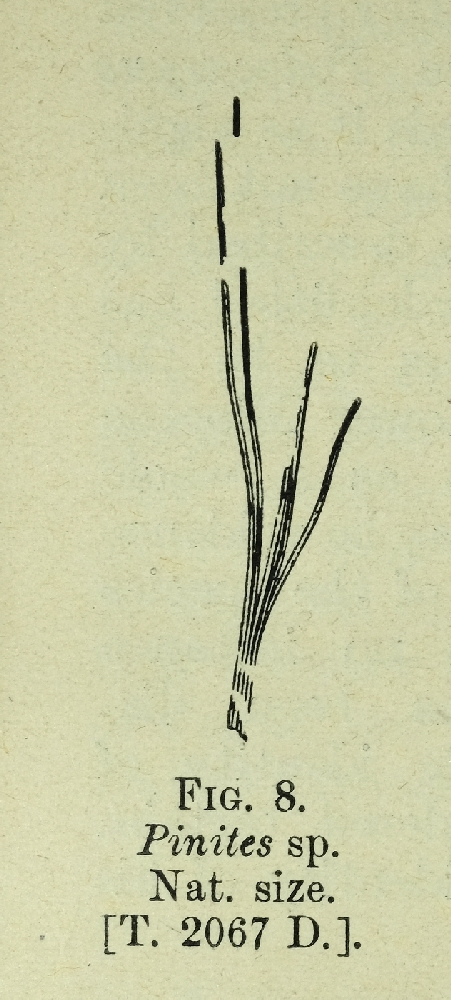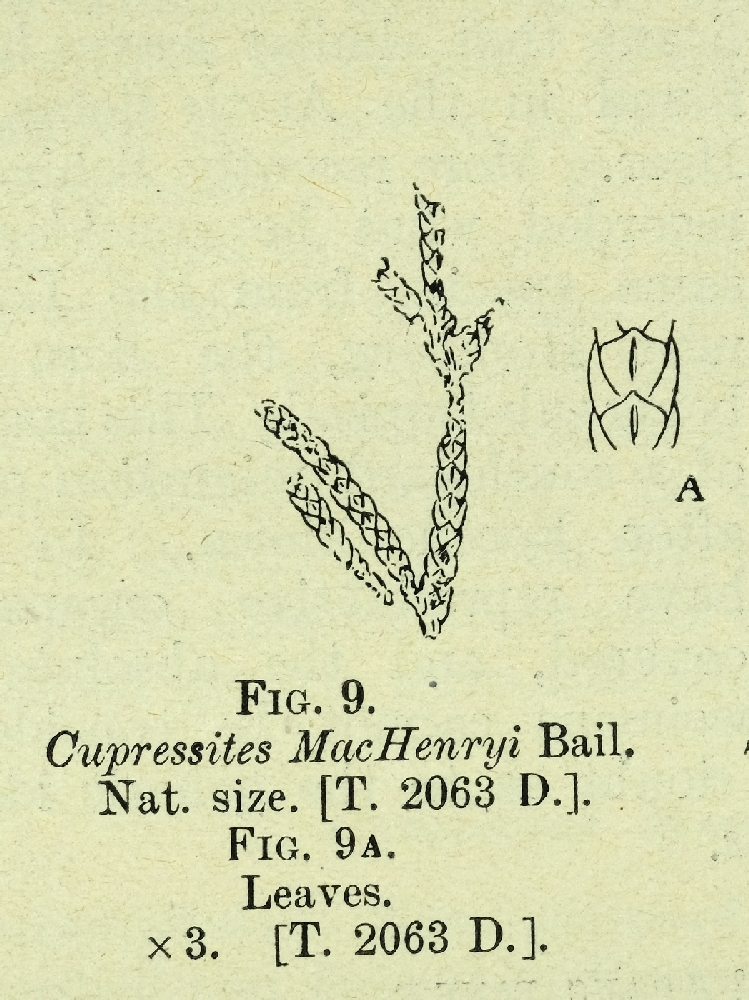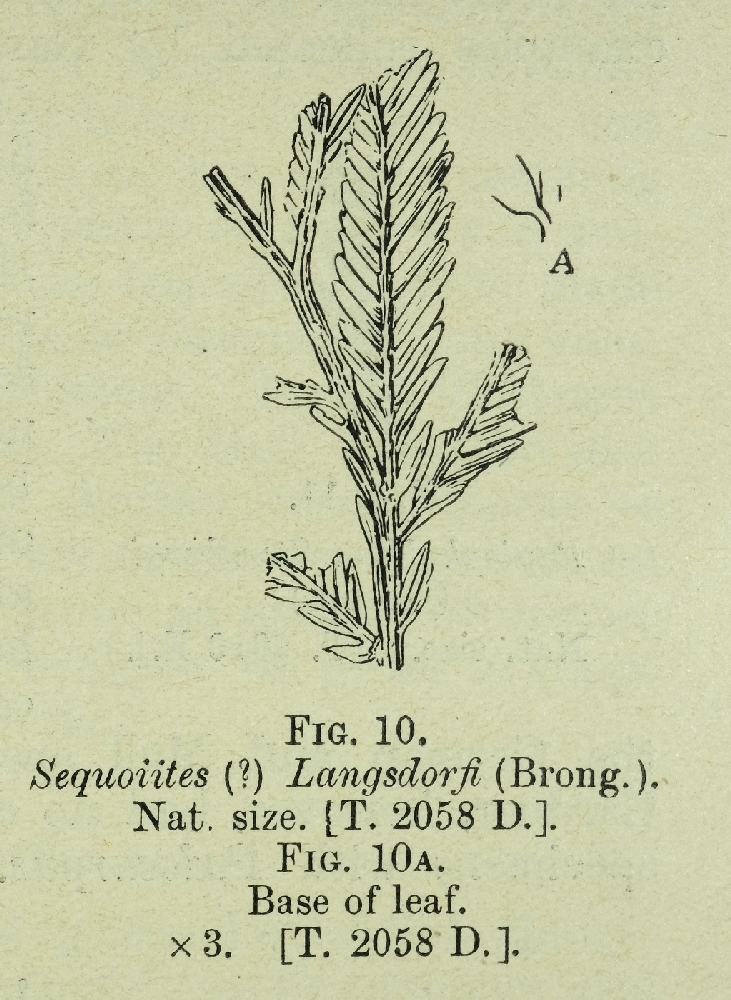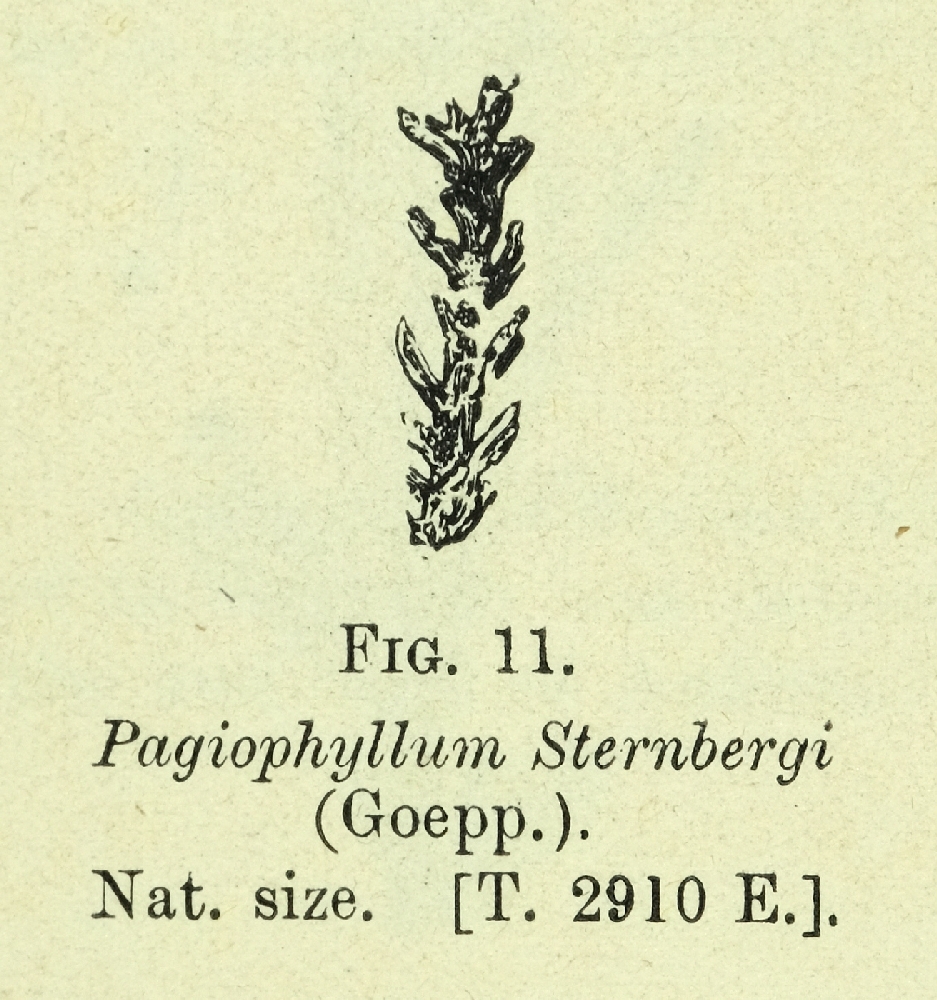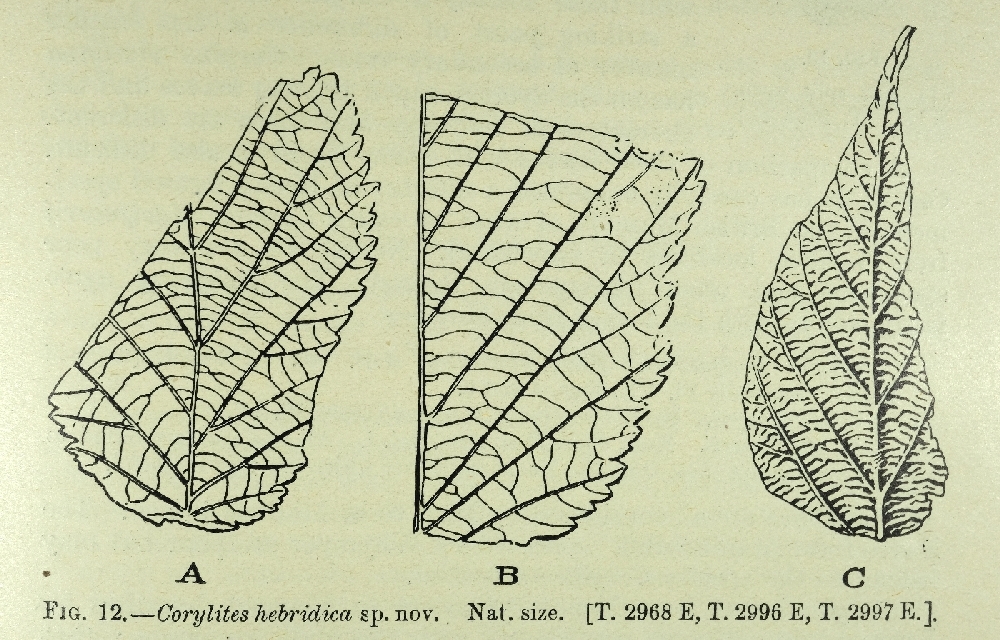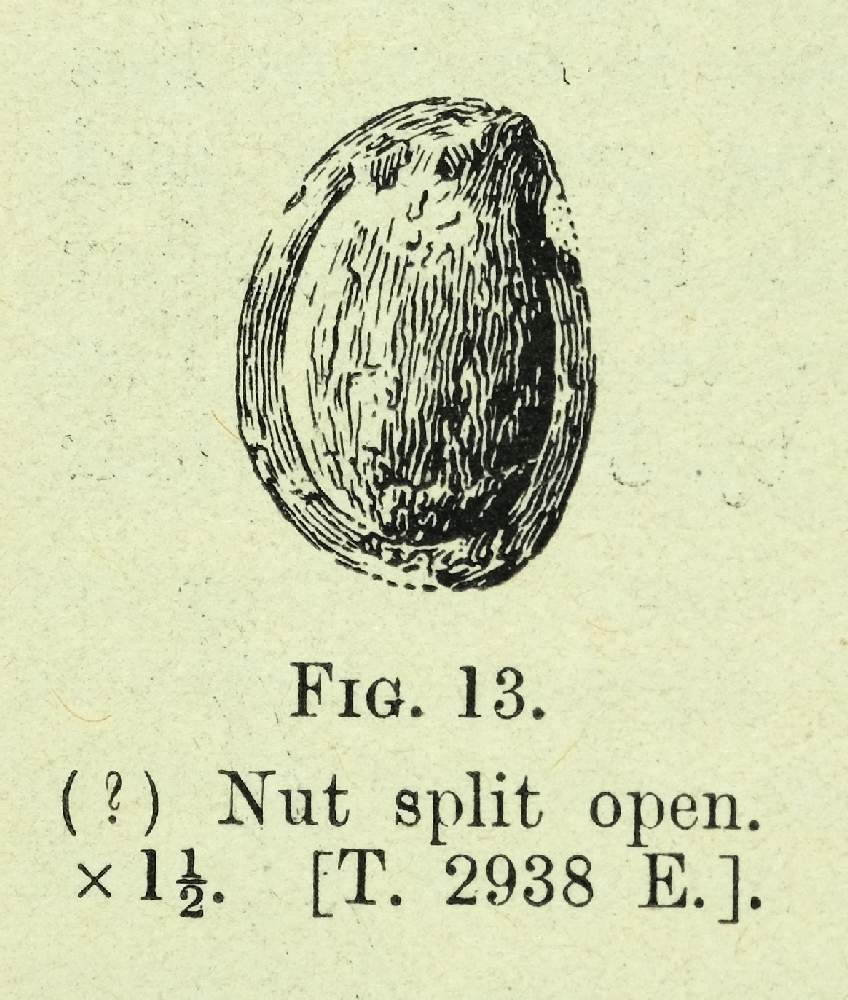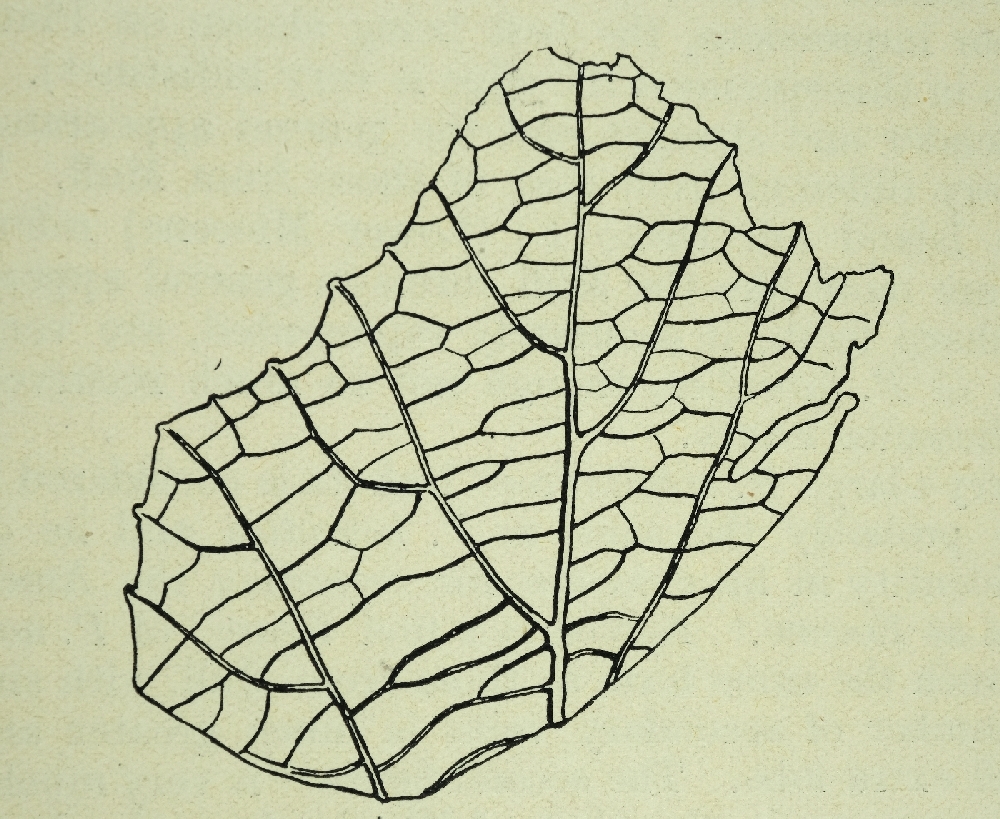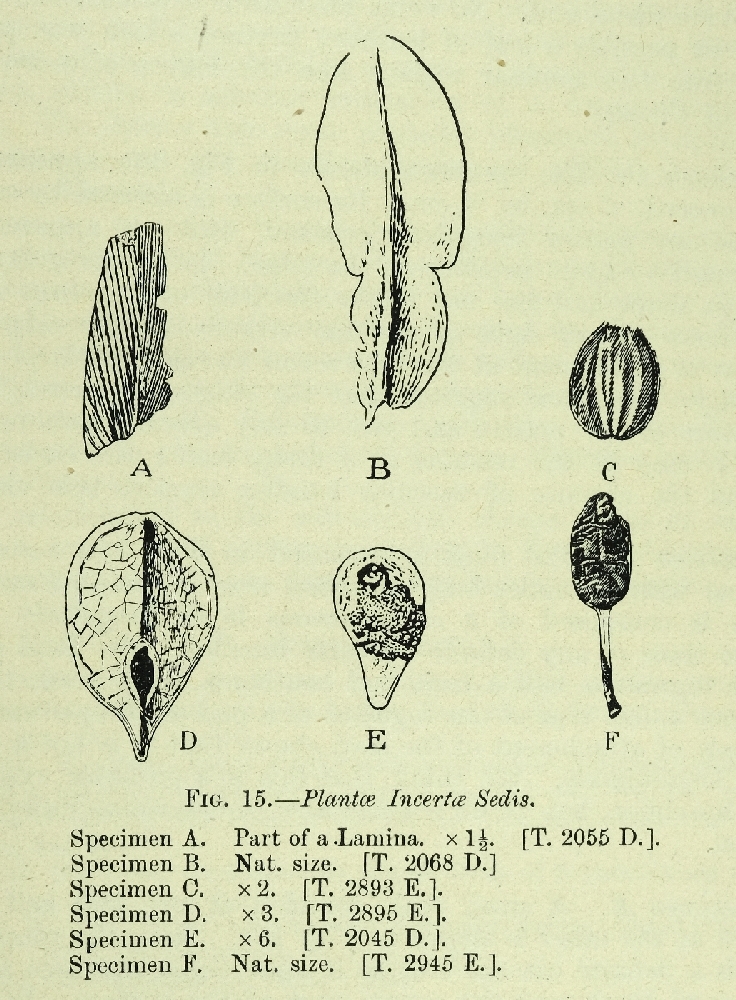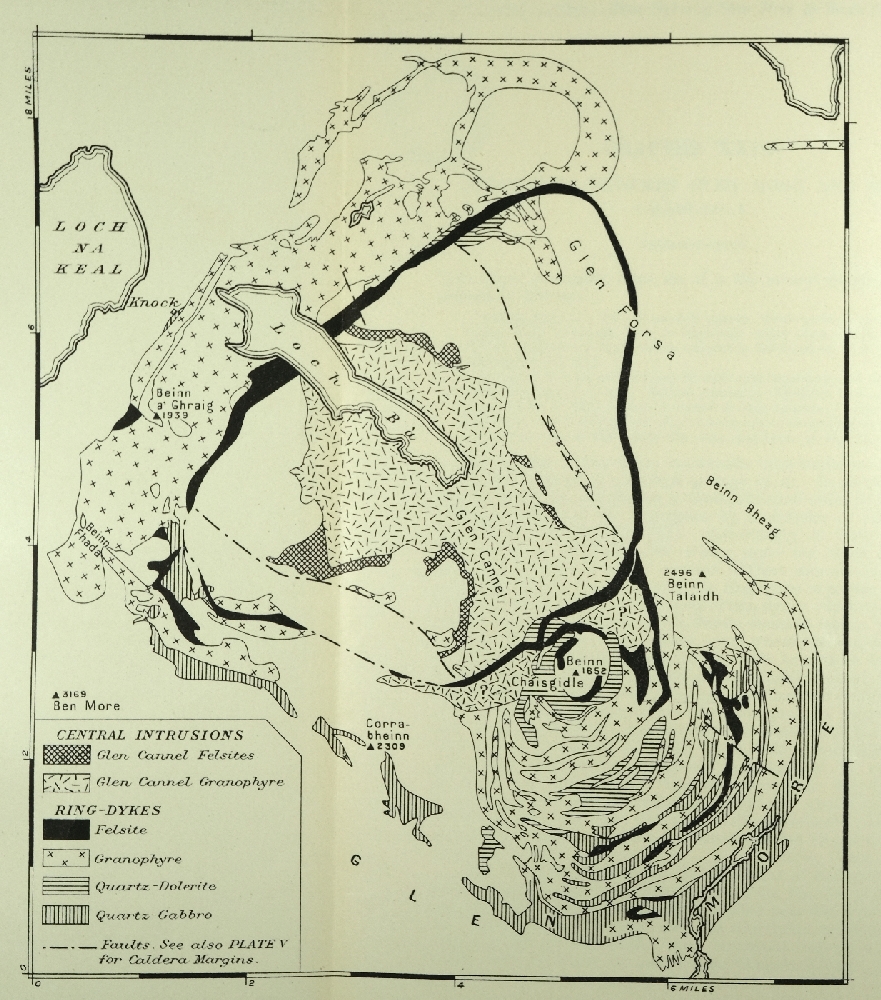Chapter 4 Tertiary plants from Mull* .
By A. C. Seward and R. E. Holttup
Introduction
The specimens which form the subject of the present Report were sent to one of us for examination from the Museum of the Geological Survey, Edinburgh. They were collected by Mr. Tait from two localities (i) the Ardtun leaf-beds at Bunessan, the locality from which Mr. Starkie Gardner collected numerous specimens (p. 61), and from (ii) a new locality at Carsaig discovered by Mr. Tait: the latter beds occur near the base of the volcanic succession and are believed to be approximately on the Ardtun horizon (p. 64). The great majority of the fossils are impressions of leaves usually far from complete and unfortunately without any carbonaceous films which could be examined microscopically. Our attention has been mainly concentrated on the Geological Survey collection, but use has also been made of the more satisfactory material collected by Mr. Starkie Gardner and now in the British Museum. Though it is seventy years since Tertiary plants were discovered in the Island of Mull the flora as a whole has never been thoroughly investigated. We hope that in the near future it may be possible to undertake a more thorough examination of all the available material from the Island. Our immediate object is to determine as far as we can the specimens submitted to us, to form an opinion on the botanical character of the vegetation and of the geological age of the Mull leaf-beds.
For many years past the investigation of the older Tertiary floras of Britain has been neglected while on the other hand the researches of the late Mr. Clement Reid, and more recently those of Mrs. Reid, have demonstrated the possibilities of palaeobotanical work when the material consists largely of fruits and seeds.
The literature on Tertiary plants is both voluminous and scattered, and unfortunately many of the published generic names have been adopted without any evidence that systematists could accept as satisfactory. Many leaf impressions, however perfect, cannot be identified with confidence, and it is even asserted that in the absence of fruits and seeds, or flowers the palobotanist's task is foredoomed to failure. There would seem to be two alternatives; either wholly to neglect fossil angiospermous leaves or with the assistance of expert systematists to endeavour to steer a middle course between the over-confidence of the enthusiast, who cannot resist the temptation of naming specimens which are indeterminable, and the extreme caution of the botanist, who declines to commit himself to definite opinions which cannot be supported by evidence such as he is accustomed to demand from recent plants. In dealing with Tertiary plants it is easy to be destructive and to throw doubt on the conclusions of other authors. Mere destructive criticism is of little value from the point of view of definite progress. Our aim is to discard material that in our opinion cannot be determined with reasonable confidence, and to satisfy ourselves that the opinions expressed are based on evidence that would not be considered inadequate by botanists possessing a considerable knowledge of the taxonomy of recent plants.
Our thanks are due to Dr. Lee and Mr. Bailey of Edinburgh for references to literature, to Dr. Kitchin of the Jermyn Street Museum, to members of the Botanical and Geological Departments of the British Museum, particularly to Dr. Rendle and Mr. W. N. Edwards. We are also indebted to Mrs. Reid for examining and reporting upon some specimens submitted to her.
In 1851 the Duke of Argyll communicated a paper to the Geological Society on the Geology of the Ardtun leaf-beds, with a note by Professor Forbes on the fossil plants.
In 1870 Dr. Grieve and Mr. Mahony exhibited a series of fossils from the leaf-beds of Mull at a meeting of the Natural History Society of Glasgow. The leaf-beds were assigned, for reasons not specified in the Report, to the Miocene period.
A Committee of the British Association appointed to collect and report on Tertiary plants from the north of- Ireland issued four Reports in 1879, 1880, 1881, and 1883. In the third Report (drawn up by W. H. Bailey) it is stated that " by the identification of these plant remains we are enabled to fix the period in which they lived as being lower Miocene they also afford strong evidence of being contemporaneous with other volcanic districts such as those Of the Island of Mull on the west coast of Scotland and of north Greenland, where mid-European plants such as these once flourished." The few illustrations of the plants given are not very satisfactory, but Gardner
In 1881 Mr. W. E. Koch contributed notes On Mull and its Leaf-beds to the Geological Society of Glasgow. He described a section through the middle leaf-bed "on the north-east side of a glen leading to the sea." His description agrees fairly well with that later given by Gardner except that he found no break in the fossiliferous succession between the middle leaf-bed and a brown soil below, which latter contained roots and branches, one of them "5 inches across and another 2 inches across, and ½in. thick. This bed," he added, "rests on eruptive matter and here I believe we are on the site of the old forest." The, discovery of a local basal root-bed was confirmed by Gardner; but its presence hardly warrants Mr. Koch in dispensing with the swampy lake in which the Duke of Argyll pictured the accumulation of fallen leaves.
The Committee appointed by the British Association to report on the fossil plants of the Tertiary and Secondary beds of the United Kingdom issued Reports in 1885 and 1886 without any reference to the Mull Flora. The second Report contains a paragraph remarking on the inadequacy, from a botanical point of view, of leaf-impressions alone for the identification of genera and species of plants.
Several references are made to the Mull plants in a Monograph on the British Eocene Flora by Baron Ettingshausen and Mr. Starkie Gardner. In the first part, by both authors,
The following lists give (A) the plants recorded by previous authors with the addition of the names adopted in the present paper and (B) the plants described by us
| A. | |
| Forbes, 1851 | A.C.S. and R.E.H. |
| Taxites (?) Campbelli Forbes. | Elatocladus Campbelli (Forbes). |
| Filicites (?) hebridicus Forbes. | Onoclea hebridica (Forbes). |
| Equisetum Campbelli Forbes. | Equisetum Campbelli Forbes. |
| Rhamnites (?) multinervatus Forbes. | |
| R. major Forbes. | |
| R. lanceolatus Forbes. | |
| Platanites hebridicus Forbes. | Platanus hebridica Forbes. |
| Alnites (?) MacQuarrii Forbes. Gardner, 1886 | |
| Cryptomeria Sternbergii Goepp. | Pagiophyllum Sternbergi (Goepp). |
| Ginkgo adiantoides (Ung). | Ginkgo adiantoides (Hug). |
| Podocarpus eocaenica Ung. (recorded but not figured from Mull). | |
| Podocarpus Campbelli Gard. Gardner, 1887 |
Podoccopus Campbelli Gard. |
| Sequoia Langsdorfii Heer. | Sequoiites (?) Langsdorfi (Brongn). |
| Glyptostrobus europoeus Heer. | |
| Podocarpus borealis Gard. | |
| Quercites greenlandieus Heer. | Quercas greenlandica Heer. |
| Boehmeria antiqua Gard. | |
| Grewia crenulata Heer. | |
| B. | |
| Pteridophyta | |
| Equisetales. Equisetum Campbelli Forbes. | |
| Filicales. Onoclea hebridica (Forbes). | |
| Gymnospermae | |
| Ginkgoales. Ginkgo adiantoides (Ung). | |
| Coniferales. | |
| Abietinem. Finites sp.* | |
| Cupressinem, Cupressites .MacHenryi Bail.* | |
| Sequoiinere. Sequoiites (?) Langsdorfi (Brongn).* | |
| Podocarpinetae. Podocarpus Campbelli. Gard. | |
| Araucarinese ( ?). Pagiophyllum Sternbergi (Goepp). | |
| Coniferales incertie sedis. | |
| Elatocladus Carapbelli (Forbes). | |
| Coniferous Wood. | |
| A. Cupressinoxylon sp. | |
| B. Wood in Lava. | |
| Angiospermae. Dicotyledones. | |
| Betulacem. Corylites hebridica sp. nov. | |
| Dicotyledonous Wood (? Betulacem). | |
| Fagaceae, Quercus greenlandica (Heer). | |
| Platanaceae. Platanus hebridica (Forbes). | |
| Dicotyledones incertie sedis. | |
| Phyllites platania (Heer). | |
| Phyllites ardtunensis sp. nov. | |
| Phyllites spp. | |
| Plantae Incertae Sedis. | |
| Specimen A* | |
| Specimen B* | |
| Specimen C | |
| Specimen D | |
| Specimen E.* | |
| Specimen F | |
| The species with an asterisk are from Carsaig; the others from Ardtun |
Description of specimens
Insecta
Mr. Starkie Gardner figured an elytron of a beetle and the "hind wing of a Cercopid insect"
"For permission to examine these interesting specimens I am indebted to Professor Seward."
Pteridophyta
Equisetales
Equisetum Campbelli Forbes. The largest specimen is an impression of an aerial shoot 12.5 cm. long with internodes 1–1.5 cm. in length
An examination of the original specimen figured by Forbes
The specimen reproduced in
Filicales
Onoclea hebridica (Forbes). The fragmentary impressions of this fern do not enable us to add anything to the description of the Mull specimens previously published,
These spores agree closely with those of the recent species Onoclea sensibilis and support the generic identification based on sterile fronds. The genii's Onoclea, represented by a single species, occurs in eastern North America from Newfoundland to Florida and extends to Saskatchewan and Nebraska; it also occurs in Japan and north-east Asia. Like many other plants it has a discontinuous range and the fossil records show that the genus had a wider and more continuous geographical distribution in the early Tertiary period. Christ
Sterile fronds of Onoclea were described by Forbes and later by Gardner from Mull. The same species is recorded by Heer
Newberry, in his original remarks on the fossil leaves, notes the wide range of variation in the living species and states that he is unable to separate the fossil from the recent fern.
Gymnospermae
Ginkgoales
Ginkgo adiantoides (Ung). Only one imperfect fragment of a leaf of this species was detected among the fossils submitted to us from the leaf-beds of Ardtun.
Coniferales
Abietineae
Pinites sp. The impression from Carsaig represented in
It is impossible in the absence of more satisfactory material to identify the specimen with confidence, but we are inclined to regard it as evidence, though not amounting to proof, of the occurrence in the Mull flora of a species of Pinus similar in its foliage to the existing species Pinus Strobus. Gardner makes no mention in his monograph of the occurrence of five-needled Pines. A similar foliar spur is figured by Saporta
Cupresseae
Cupressites MacHenryi Bail. The impression of a small piece of branched shoot from Carsaig shown in Fig, 9 appears to be identical with the Irish species first figured by Bailey
The leaves of the Mull specimen are small and scale-like and are arranged in decussate pairs
Sequoiineae
Sequoiites (?) Langsdorfi (Brongn). Among the specimens sent to us there are a few from Carsaig which appear to be identical with the small twig compared by Gardner with those from Greenland described by Heer as Sequoia Langsdorfii.
Podocarpineae
Podocarpus Campbelli Gard. A few rather poor specimens of leaves are most probably of the same species as the better preserved examples collected by Gardner and named by him Podocarpus Campbelli.
?Araucarineae
Pagiopyllum Sternbergi (Goepp). The piece of vegetative shoot represented in
Coniferales Incertae Sedis
Elatocladus Campbelli (Forb). The Mull specimen on which Forbes
Coniferous Wood
A. Cupressinoxylon sp.
Some pieces of lignitised wood from the upright tree described and figured by Macculloch
The annual rings are well marked, but owing to the crushed condition of the tissues it is impossible to give a detailed description of the spring and summer wood. There are no resin-canals. The frequent occurrence of dark brown material, presumably resin, filling the cavities of cells in vertical rows, with an occasional transverse wall preserved, indicates the presence of resiniferous xylem-parenchyma which is not confined to any particular region. There is usually a single row of circular bordered pits on the radial walls of the tracheids; rarely the pits are in contact and slightly flattened. Rims of Sanio are occasionally preserved. The medullary rays are numerous and uniseriate, and deep. One or two, pits occur in the field (i.e. the area bounded by the radial walls of a ray cells and the vertical walls of a tracheid as seen in a radial section) which are either oval or circular: in the oval pits the major axis is approximately radial (horizontal). There are no pits in the tangential or transverse walls of the ray cells.
B. Fragments of Coniferous wood enclosed in lava from river mouth, S.E. of Tavool House
The occurrence of these fragments is dealt with on p. 113. Their preservation is much less satisfactory and we cannot with any confidence refer them to a genus. The annual rings are numerous and narrow, the narrower late summer tracheids, which are very sharply contrasted from the larger spring tracheids, being confined to a very narrow zone in each ring. There are no resin-canals and no indication of resiniferous parenchyma. In the absence of such characters as the pitting of the tracheids and the pitting of the medullary-ray cells it is impossible to attempt a diagnosis of the material.
Angiospermae: dicotyledones
Betulaceae
Corylites hebridica sp. nov.
A careful examination of the type of Forbes's species Alnites MacQuarrii in the Jermyn Street. Museum shows that, with the exception of the slightly cordate base, the leaf is incomplete and the apparent teeth on the margin are the result of tearing of the lamina. There is one
The specimens represented in
The question of referring these leaves to a recent genus is a very difficult one. Gardner
On leaf characters alone the recent genera Carpinus, Betula, and Alnus cannot confidently be separated.
- Corylus MacQuarrii. Heer, Flor. Foss. Ant. vol. v., Pt. I. (Grinnell Land); especially Pl. VI., Figs. 4 and 6.
- C. MacQuarrii. Heer, Flor. Foss. Alaskana (1869), Pl. IV.
- C. MacQuarrii. Heer, Flor. Foss. Arct. vol. i. All the leaves referred to this type except those from the Mackenzie River which are very doubtful.
The above are all considered by Heer to be Miocene in age. The leaves from Atanikerdluk
There are various references of leaves by American authors to C. MacQuarrii, but none of them are very satisfactory. One of Lesquereux's figures
The comparative study of these American leaves is not easy; so few examples are given from each locality that it is impossible to get a general idea of the range of form of each type. In general it may be said that none of the figures mentioned shows a really close agreement with the Mull Corylites. However the experience gained by examining specimens of one recent species from different localities indicates that it is not impossible that some of the American fossil leaves .may be varieties of the species found at Mull. But one cannot say exactly how much latitude should be allowed in this matter.
Though we cannot assert, from a botanical point of view, that the Mull leaves are proved to belong to the genus Corylus, we think that they agree more closely with that genus than with any -other and may reasonably be included in Corylites.
Dicotyledonous Wood (? Betulaceae)
We have examined sections of portions of a prostrate trunk which occurs at Uamh Mhic Cuill, Rudha na h-Uamha, enclosed in the same lava as the Cupressinoxylon described above (see also p. 112).
The wood appears to be most nearly related to that of members of the Betulaceæ, particularly Betula, but there are certain differences. It agrees with Betula, in the radial groups of vessels, the oblique ends of the vessels being crossed by numerous fine scalariform bars, and in the number and size of the medullary rays some of which are uniseriate and some as much as four cells in width. No aggregate rays are present in the sections examined. Vessels appear to be evenly distributed throughout the transverse section. No annual rings have been detected, but only a small part of the section shows well-preserved structure. Points of difference from Betula are the presence of irregular large scalariform or rounded bordered pits on the wall of contact of one vessel with another, instead of the closely packed very small pits of Betula, and a peculiar ray character which is present to a small extent in Betula alba, but more marked in species of Fagus. The broader rays of the fossil wood consist of narrow cells, radially elongated, with one or more rays of larger cells, not radially elongated above and below them. The cells of the uniseriate rays are also of this latter kind, and it frequently happens that two broader rays are connected vertically by a plate of the larger cells. In the Birch there are indications of this but the disparity of size between the two kinds of cells is not so great.
It is hoped to publish a more detailed description of this wood in the near future. At present we refrain from giving it a name.
Fagaceae
Quercus greenlandica Heer. Gardner
There appears to be no distinction between Q. greenlandica and Fagus castanecefolia Ung. as figured by Heer in the Flor. Foss Arct. Vol. I., Plate XLV., and the latter in his Flor. Alaskana
It is extremely difficult to separate these leaves into different species, especially when one takes into account the close resemblance between leaves of some existing species of Quercus and those of species of Castanea, and the small amount of difference between the leaves of different species of the latter genus. Thus it is possible that Heer is justified in separating the leaves called by him Castanea Ungeri, though some of those referred to Fagus castanecefolia are indistinguishable from Q. greenlandica. He records but does not figure flowers and fruit of C. Ungeri from Atanikerdluk
There is one reference of leaves found in America to this species by Newberry
As several authors have remarked, it is impossible to decide definitely on leaf characters alone, whether a doubtful leaf belongs to the genus Quercus or to Castanea. The very blunt and prominent teeth of Q. greenlandica resemble very closely those of Q. Prinus and other oaks and cannot be matched in any Castanea: though not absolutely certain, it would seem very probable that we are here dealing with a true Quercus.
Platanacae
Platanus hebridica (Forbes)
The only pubished figures of leaves of this species arc those of Forbes,
The leaves vary considerably in size and shape. Gardner records one, 37 cm. in length. In the present collection we have only three undoubted specimens, all imperfect; the smallest of these, which shows the edge of the lamina most clearly is represented in
Of the leaves in the British Museum many are nearly 20 cm. in length, and are all imperfect. They are typically three-lobed, the lateral lobes being usually rather narrow and ending in sharp points. There occur also large leaves in which these lateral lobes are, almost suppressed. The edge is nearly smooth, or with small projections at the ends of the main veins
Gardner
Newberry's large P. nobilis from Dakota is considered by Knowlton to be probably the same as P. hebridica and he quotes this supposed identity in his evidence for regarding the American Fort Union beds as Eocene.
Perhaps also P. Raynoldsii var. integrifolia Lesq.
Lesquereux's P. primaeva
Upper Cretaceous leaves from Kunstadt described by Krasser
Dicotyledons Incertæ Sedis
Phyllites platania (Heer)
One leaf impression in the recently obtained collection, though showing no edge, is very similar in venation and size to some large leaves obtained by Gardner. These leaves agree closely with those called by Heer Quercus platania from Atanikerdluk
Phyllites ardtunensis sp. nov
The British Museum collection of Mull plants includes numerous well-preserved impressions of leaves of the type figured by Gardner on Plate XIV. (Fig. 3) of his paper published in 1887, though most of them are larger than his figure. The specimen reproduced in Plate II. (British Museum coll) is 15 cm. long. Among the fossils sent to us there are two very imperfect specimens which belong to this type. The leaves are ovate, usually with a broad, almost straight base at right-angle. to the petiole. At the apex the lamina tapers off evenly to a point. On the edge are numerous small, not quite evenly placed, strongly recurved narrow teeth. The secondary veins are numerous and strongly marked. They are more crowded at the base where they are almost straight and nearly at right-angles to the midrib; higher up they are distinctly curved. Near the margin of the leaf the secondary veins usually fork in a very characteristic fashion, sometimes twice or even three times, the ends of their branches entering the marginal teeth. Of these leaves, Gardner remarks that they seem as yet peculiar, and we can only repeat that statement. In searching the records of both American and European Tertiary floras we cannot find any leaves which at all closely resemble them.
Among fossil leaves that most nearly resemble them in shape and in the arrangement of the secondary veins is Saporta's Fagus pristina,
Phyllites spp.
The Survey collection includes leaves undoubtedly specifically identical with those figured by Gardner (1887) in his Figs. 3 and 4, Plate XVI., also larger leaves probably of the same species as those named by Forbes
We feel at present entirely unable even to suggest the probable genera to which these leaves belong, and as in this case the leaves are of no use for comparison of the Mull flora with those of other localities we do not propose to describe the fossils in detail.
Plantie incertæ sedis
Specimen A
The fragment represented in
We propose to refrain from giving a name to the Mull specimen as it is too small to determine with any degree of confidence, but we are inclined to think it may be identical with, or at least closely allied to, Protophyllocladus subintegrifolius (Lesq).
Specimen B
The specimen shown in
Specimen C
The specimen shown in
Specimen D
The fossil represented in
Specimen E
A small scale rounded at one end and bluntly pointed at the other is shown in
Specimen F
The stalked object shown in
Conclusion
The collection dealt with in this paper is by no means fully representative of the Mull flora. Some of the most interesting types, e.g. the leaf called by Gardner Boehmeria antiques, are absent or represented by very poor specimens in the material which we have examined. A few very imperfect leaf fragments we have been unable to identify and have not described them.
The vegetation from the leaf-beds of Ardtun indicates that the climate was temperate like that of the regions in which at present summer deeidnous forest is typically developed. The great majority of the leaves from Mull are those of deciduous trees such as Platanus, Corylites, and Quercus though the probable presence of such Conifers as Podocarpus and A raucaria points to a warmer climate than exists over most of the British Isles to-day. The possible presence of evergreen shrubs is another indication of a warm; fairly moist climate. The leaves were most probably preserved by falling into a still lake round the marshy borders of which Onoclea and Equisetum flourished.
We see no reason to dissent from Gardner's opinion, expressed in 1887, that the flora is Eocene; it may well be, as Gardner believes Lower Eocene. A relationship with the Lower Tertiary floras of Greenland and other Arctic regions—regarded by Heer as Miocene, but by Gardner and other more recent writers as Eocene—is undoubtedly indicated by Corylites, Quercus greenlandica, and possibly by Quercus Platania. Relationship with the Laramie floras of North America is also suggested by Onoclea, Platanus, and possibly Quercus Platania.
The relationship to the sub-tropical Eocene floras of southern Europe is less marked: these according to Berry exhibit a closer resemblance to the Eocene floras of Carolina and Georgia.
Bibliography
ARGYLL, DUKE OF (1851), On Tertiary Leaf-beds in. the Isle of Mull. With a note on the Vegetable. Remains from Ardtun HeAl by E. Forbes. Quart. Journ. Geol. Soc., Vol. vii., p. 89.
BAILEY, W. H. (1869), Notice of Plant-remains from beds interstratified with the Basalt in the county of Antrim. Quart. Journ. Geol. Soc., Vol. xxv., p. 357.
BAILEY, W. H. (1914), The Upper Cretaceous and Eocene Floras of S. Carolina and Georgia. U.S. Geol. Surv., Prof. Paper 84.
BERRY E. W. (1911), The Flora of the Raritan Formation. Geol. Surv., New Jersey, Bull iii.
BERRY, E W., and others (1916), Maryland Geological Survey: Upper Cretaceous.
CHRIST, H. (1897), Die Farnkräuter der Erde. Jena.
CHRIST, H. (1910), Die Geographie der Farne. Jena.
COCKERELL, T. D. A. (1921), Some British Fossil Insects. Canadian Entomologist, Vol. liii., p. 22.
DAWSON, SIR W. (1889), On Fossil Plants collected by Mr R. A. MacConnell on Mackenzie River, and by T. C. Weston on Bow River. Trans. R. Soc., Canada. Vol. vii., Sect. iv., p. 69.
ETTINGSHAUSEN, C. von (1855), Die Tertiäre Flora von Häring im Tirol. Abh. K.k.geol. Reichs. Wien., Bd. ii., Abt. ii., No. 2.
ETTINGSHAUSEN, C. von (1886), Beitrage zur Kenutniss der Tertiarflora Australiens. Denkschr. K. Akad. Wiss. Wien., Bd. liii.
FORBES, E. (1851), See Duke of Argyll.
GARDNER, J. S., and C. VON ETTINGSHAUSEN (1882), Monograph of the British Eocene Flora. Palceont. Soc., London.
GARDNER, J. S. (1886), Ibid., Vol. ii.
GARDNER, J. S. (1887), On the leaf-beds and gravels of Ardtun, Carsaig, etc. in Mull, with notes by G. A. J. COLE, Quart. Journ. Geol. Soc., Vol. xliii., p. 270.
GOEPPERT, H. R. (1855), Die Tertiäre Flora von Sehossnitz in Schlesien, Gorlitz.
HALLE, T. G. (1913), The Mesozoic Flora of Graham Land. Wiss. Ergeb. Schwed. südpol. Expect., 1901–03, Bd. iii., Lief. 14.
HERR, O. (1859), Flora Tertiaria Helvetiae, Bd.
HERR, O. (1868), Flora Fossilis Arctica, Bd. i., Zurich.
HERR, O. (1869), Contributions to the fossil Flora of N. Greenland, being a description of plants collected by E. Whymper during the Summer of 1867. Phil. Trans. B. Soc. (Included in the Flor. Foss. Arct., Bd. ii).
HERR, O. (1869), Flora Fossilis Alaskana. (Flor. Foss. Acad., Bd. ii).
HERR, O. (1874), Nachträge zur Miocenen Flora Grönlands (ibid., Bd. iii).
HERR, O. (1883) Flor. Foss. Arct. Bd. vii.
HOLLICK, A. (1906), The Cretaceous Flora of southern New York and New England. U.S. Geol. Surv. Monograph 50.
KNOWLTON, F. H. (1898), Catalogue of the Cretaceous and Tertiary plants of North America. U. S. Geol. Surv., Bull. 152.
KNOWLTON, F. H. (1902), Report on a small collection of fossil plants from the vicinity of Porcupine Buttes, Montana. Bull. Torrey Bot. Club, Vol. xxix.
KNOWLTON, F. H. (1909), On the stratigraphic relations and paleontology of the Hell Creek Beds, Ceratops Bed, and equivalents, and their reference to the Fort Union formation, Proc. Washington. Acad. Sci., Vol. xi.
KNOWLTON, F. H., and W. T. LEE (1917), Geology and Paleontology of the Raton Mesa and other regions in Colorado and New Mexico., U.S. Geol. Surv. Prof. Paper 101.
KRASSER, F. (1896), Beiträge zur Kenntniss der Kreideflora von Kunstadt in Mähren, Beit. Paleont; Geol. Osterr.-Ungarn. and des Orients, Bd. x., Heft. iii., Wien.
LAURENT, L. (1912), Flore fossile des Schistes de Menat, Ann. Mus. d'hist. nat. Marseille, Geol., Tome xiv.
LESQUEREUX, L. (1874), Contributions to the Fossil Flora of the Western Territories. Pt. i. The Cretaceous Flora, Rep. U.S. Geol. Surv. Territ., Vol. vi.
LESQUEREUX, L. (1878), Ibid., Pt ii., The Tertiary Flora, Rep. U.S. Geol. Surv. Territ., Vol. vii.
LESQUEREUX, L. (1892), The Flora of the Dakota group, U.S. Geol. Surv. Monograph xvii. MACULLOCH, J. (1819) Description of the Western Islands of Scotland, London.
MENZEL, P. (1910), Pflanzenreste aus dem Posener Ton. Jahrb. K. Preuss. Geol. Landesanst, Bd. xxxi, Tl. i, Heft i.
NEWBERRY, J. S. (1895), The Flora of the Amboy Clays, U.S. Geol. Surv., Monograph xxvi.
NEWBERRY, J. S. (1898), Later extinct floras of N. America, U.S. Geol. Surv., Monograph xxxv.
REIMANN, H. (1917), Die Betulaceen and Ulmaceen des Schlesischen Tertiärs, Jahrb. Preus. geol. Landesanst, Bd. xxxviii., Tl. ii, Heft i.
SAPORTA, G. de (1873), Etudes sur la végétation du Sud-est de la France a époque Tertiare, Ann. Sci. Nat. [5] Tome xvii.
SAPORTA, G. de (1893), Revue des Travaux de Paleont. veg. parus en France dans le cours des ann. 1889–92, Rév. Gén. Bot., Tome v.
SCRIMPER, W. P. (1870), Traite de Paléontologie Végétale. Tome ii.
SCHINDEHÜTTE, G. (1907), Die Tertiärflora des Basalttuffes von Eichelskopf be Homberg. Abh. K. Preus. Geol. Landesanst, N. F. Heft liv.
SEWARD, A.C. (1919), Fossil Plants, Vol. iv., Cambridge.
WARD, L. F. (1887), Types of the Laramie Flora, U.S. Geol. Surv., Bull. 37.
A. C. S. , R.E.H.

